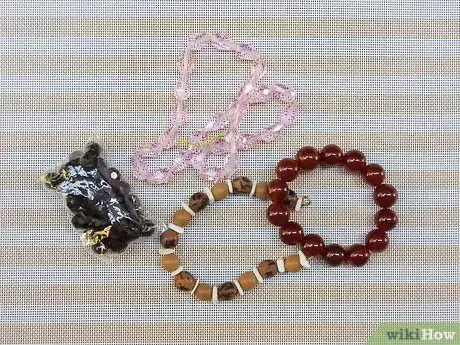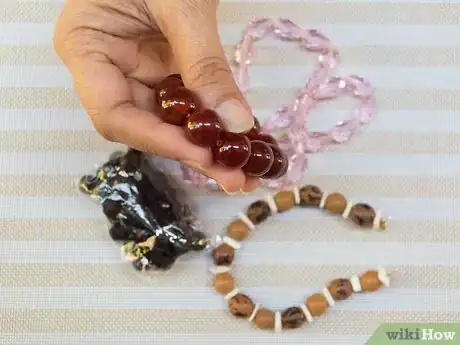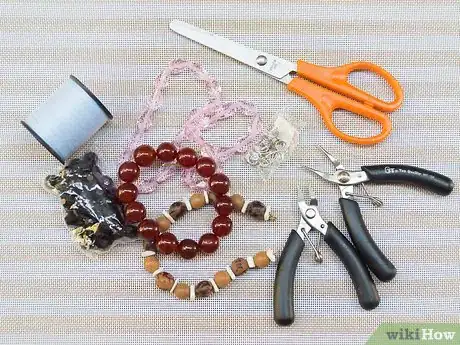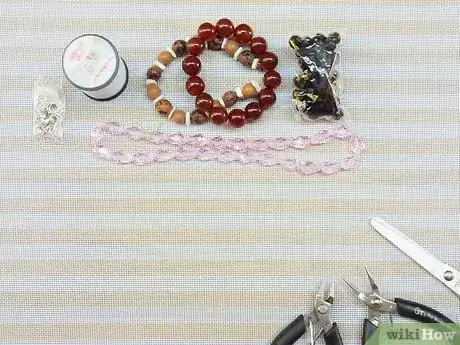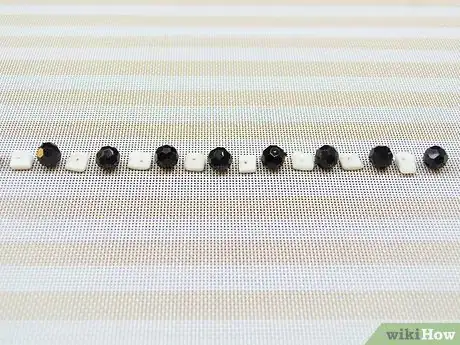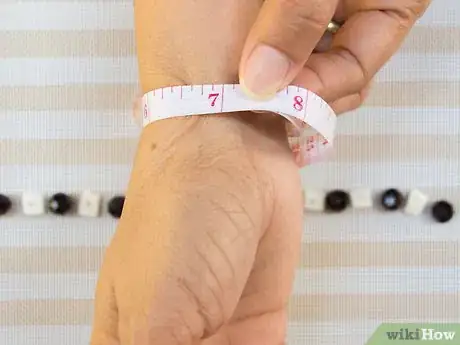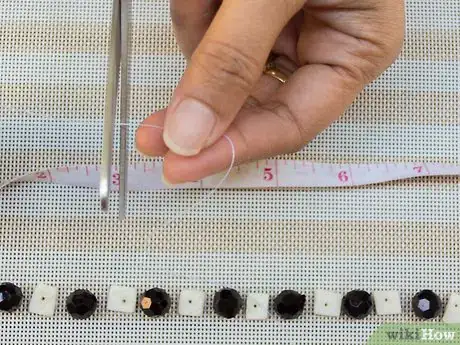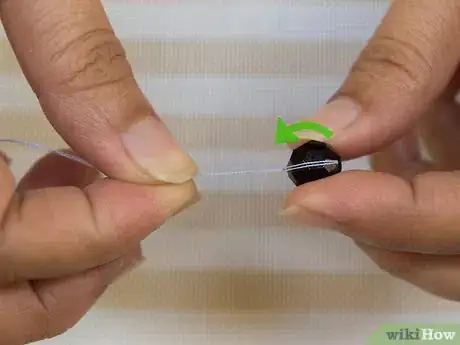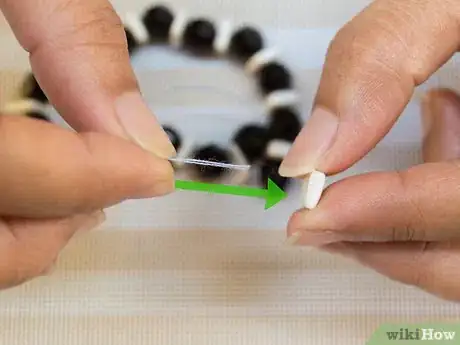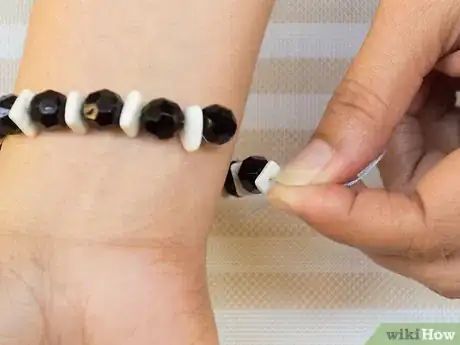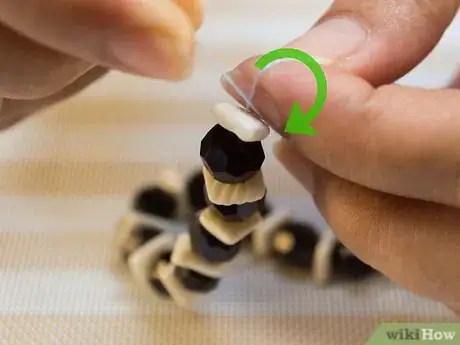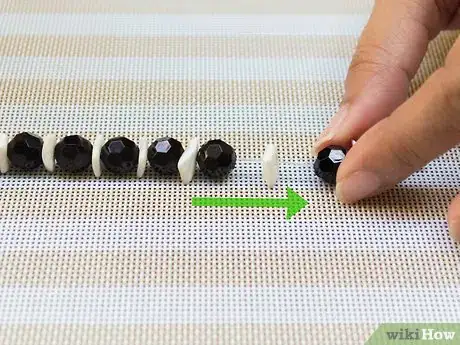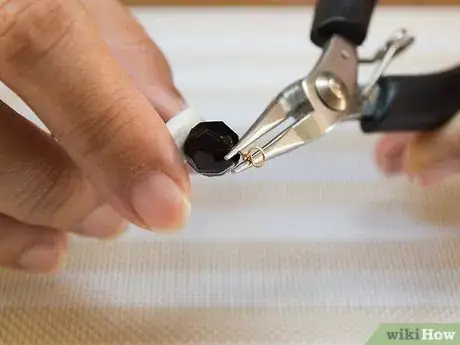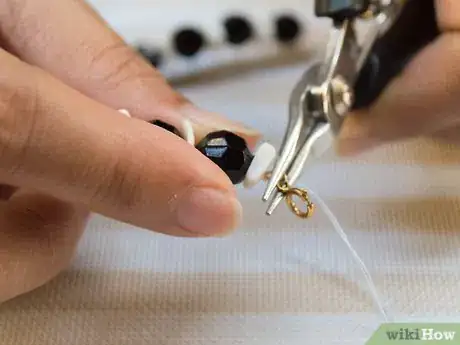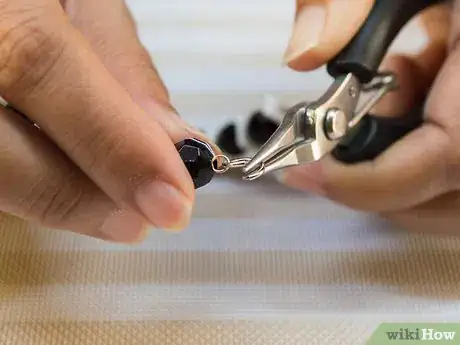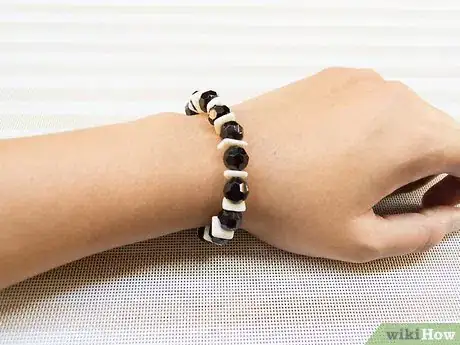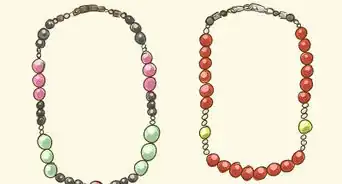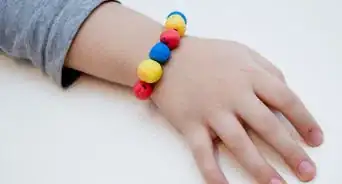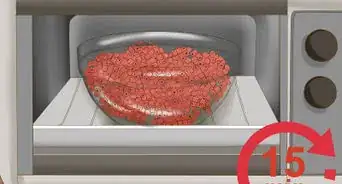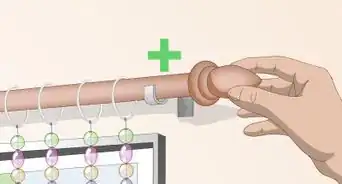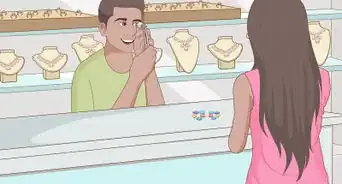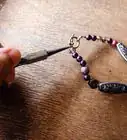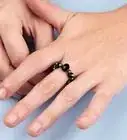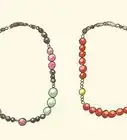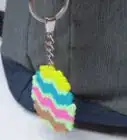This article was co-authored by Amy Guerrero. Amy Guerrero is an Arts and Crafts Specialist and the Owner of Sunshine Craft Co., a crafting studio based in Phoenix, Arizona. Amy specializes in macrame, DIY crafting, and teaching fiber arts. She offers monthly in-person and online workshops along with having developed a range of DIY craft kits for at-home projects. Amy holds a BS in Industrial Design from Philadelphia University. She worked as a graphic designer before starting her own business. Sunshine Craft Co. is a creative hub that offers a wide range of workshops, tools, and resources for any craft project to inspire creativity and community engagement.
This article has been viewed 71,769 times.
Beadwork is a popular craft due to its relatively simple components and the many different designs you can make from these. Beading generally involves stringing beads onto a line, or you can weave bead patterns with a loom. There are many variations in beading method, and a wide range of complexity between patterns you might use. Whichever you decide on, getting the hang of beading only requires the right supplies and a little effort.
Steps
Planning Your Beading Project
-
1Determine the kind of bead jewelry you'd like to create. Beading is a tremendously versatile craft. You can make a beaded ring, a beaded necklace, bead earrings, bead keychains, and more! For the purposes of providing a guided example, the process involved in stringing a simple beaded bracelet will be demonstrated.
-
2Imagine your jewelry design. For beginners, a simple pattern that uses alternating colors of same sized beads is likely best. This will prevent any complications between the bead width and thickness of the line. However, differing sizes, shapes, and colors can add variety to your design.
- Avoid sharp-edged shapes in your beads. Bracelets and necklaces that have beads with points can be uncomfortable to the wearer.
Advertisement -
3Gather your beading materials. Most beading materials can be bought at your local craft store, or even in the craft or school supply section of general retailers. You'll need to coordinate the thickness of your line with the thickness of your beads, but this can be done easily by comparing the bead thickness listed on the package of your beads with the thickness listed on the wire package. Including these, you'll also need:
- Beads (similar sized; many)
- Beading line (i.e. - fishing line, silk cord, nylon needle-end cord)
- Clasp (1)
- Fold over bead tips
- Jump ring (1)
- Round nose pliers
- Scissors
-
4Arrange your workstation. A cluttered work space can lead to beads getting knocked over or scissors misplaced. You might want to lay down a towel or cloth if you are working on a hard surface. This will allow beads to nest in the cloth, preventing runaway beads.
- For more involved beading projects, you might make use of sticky bead mats and rimmed bead trays to keep your beads organized.
-
5Lay out your pattern. Now is the time for you to organize your beads into the pattern you imagined earlier. This will help give you a sense of length for your jewelry and will also give you a preview of how the design you've chosen will look.
- For shorter length projects, simple designs are best. Generally speaking, long, complex, or intricate patterns are poorly suited for beaded rings and bracelets.
- Laying out your beads beforehand will also speed the process, saving you precious minutes spent rooting around your bead container for the bead you need.
Stringing a Beaded Bracelet
-
1Determine the length of your jewelry. You'll want the length of your beading line to be longer than your target length. This will allow you extra line if you make a mistake or need to tie a knot. Also, many designs will make use of clasps, and extra line will make the ends of your jewelry easier to work with.[1]
- Gauge the appropriate length of your jewelry for your project by holding your line up to the body part it is intended to be worn on.
- You may need to wrap your line around the body part to get the most accurate idea of the length of line you'll need.
-
2Cut your line to your desired length. Use your wire cutters to cut your cord approximately 3" (7.6 cm) longer than the target length of your bracelet. You can also use a bead board to measure out the length of your line more accurately by aligning your cord with the length markings on the board.
- If you plan on making your bracelet or other beaded jewelry without a clasp, you may want to string your beads on elastic cord so it can flex to fit the wearer.
- If using a non-elastic line, make sure your line is big enough to fit over the widest section of the body part the jewelry is intended for. This way, the bracelet can be slipped on and off.
-
3Tie a bead to one end of your line. To prevent beads from falling off the end of the cord, tie one bead approximately 1" (2.5 cm) from the end, using an overhand knot or a square knot. Pull the knot lightly so it is tight enough to hold in place, but loose enough that you can remove and use this bead later if you like.
-
4String beads from the unknotted end. Slide your beads down the length of your line to meet the stopper-bead you have tied to the knotted end. Your pattern will be added to the cord starting from that end, so you should start add beads from your pattern in sequence, from one end of the pattern to the end.[2]
-
5Check the length. It's easy to get carried away when beading! Don't worry if you think you've gone too far, simply drape your jewelry across the body part it's intended for to check the length. In the case of the guided example, hold the bracelet by the loose end to prevent losing any beads, and check to see that the design stretches all the way around the wrist.
- Feel free to add or subtract beads as necessary.
-
6Knot the ends together if forgoing a clasp. If you have decided not to use a clasp to join the ends of your bracelet, finish ends by tying them together in a surgeon's knot. This simple knot can be accomplished by:
- Creating a loop with both ends of your line.
- Feeding the ends through the loop and upward.
- Taking the ends around the top of the loop and back around and through it.
- Pulling the ends to tighten the knot.
- Adding a dab of superglue to the knot can further strengthen it (optional).
- When the glue is dry, use scissors to trim cord ends.[3]
Attaching a Clasp
-
1Remove beads to make room for your clasp, if necessary. When adding a clasp, you may need to remove a few beads from your pattern. The total length of your clasp and its parts may require a few extra inches of line that is occupied by your beads for it to be attached.
-
2Tie your cord to your clasp, if applicable. You might be able to tie your cord directly to the clasp using a few overhand knots. In some cases, you might need one or more pairs of jump rings, split rings, crimp beads, or fold-over bead tips to securely attach the cord to the clasp. Fold-over (or clamshell) bead tips have a metal loop that attaches to the clasp, or can also be used to connect to a jump ring and then a clasp.[4]
- Use a hollow cup/bead at the end of your design to hide your knot from view.
-
3Attach your fold-over bead tip. String the end of your cord through the small hole in the bead tip and bring the cord into the cupped section. Securely knot the cord so as to restrict your line from moving back through the hole. Hide the knot by carefully closing the 2 cupped halves of the bead tip toward each other with your pliers.[5]
- Your knot should be small enough to hide inside the cup, but large enough not to feed back through the hole.
- You can use a tiny bead as a stopper on the inside the cup. Simply knot this tiny bead onto your line and tuck it in the cupped portion of the fold-over bead.
-
4Link a jump ring to your fold-over bead. You'll need your pliers to bend the connector of your fold-over bead onto your jump ring. Bend the connector to the side to create a gap big enough for you to add your jump ring, and then bend the connector back into place.
- Twisting connectors and jump rings to the side will prevent the metal from becoming loosely connected.
-
5Check your handiwork. Take your bracelet around your wrist and connect your clasp to the jump ring. Make sure that the length is sufficient by wearing it for a day.[6] If the bracelet falls off your hand, is too loose, or is too tight, you may want to untie your end knot and make some adjustments.
- When you are certain your bracelet is finished, use your scissors to cut off any extra line that remains.
Community Q&A
-
QuestionWhat is the use of a spacer in beading?
 T. ChinsenTop AnswererA spacer bead separates larger beads to prevent them from rubbing against each other and the cord that they are threaded on. It helps separate colors, gives visual definition to intricate beads and helps to highlight the design of the beadwork.
T. ChinsenTop AnswererA spacer bead separates larger beads to prevent them from rubbing against each other and the cord that they are threaded on. It helps separate colors, gives visual definition to intricate beads and helps to highlight the design of the beadwork.
Warnings
- Always warn children to keep jewelry out of their mouths. Not only are beads a choking hazard, but jewelry components can contain lead, phthalates, and other elements and compounds not intended to be ingested.⧼thumbs_response⧽
- When beading with small children, make sure the children do not eat the beads.⧼thumbs_response⧽
Things You'll Need
- Beads (similar size; many)
- Beading line (i.e. - fishing line, silk cord, nylon needle-end cord)
- Clasp (1)
- Fold over bead tips
- Jump ring (1)
- Round nose pliers
- Scissors
References
- ↑ http://www.how-to-make-jewelry.com/bracelet-making-tips.html
- ↑ http://www.how-to-make-jewelry.com/mala-beads.html
- ↑ http://www.animatedknots.com/surgeonsjoin/#ScrollPoint
- ↑ http://www.bfranklincrafts.com/TipsTechniques/TipsTechniquesBeadClasps.html
- ↑ http://cdn.shopify.com/s/files/1/0196/5704/files/fold-over_grande.jpg?1686
- ↑ http://www.how-to-make-jewelry.com/bracelet-making-tips.html
- ↑ http://www.how-to-make-jewelry.com/how-to-string-beads.html
About This Article
To make beaded jewelry, start by cutting a length of fishing line that’s about 3 inches longer than you need, so you’ll have room to tie knots or add clasps at the ends. Then, use an overhand knot or a square knot to secure a bead one inch from the end, so your beads don’t fall off as you’re stringing them. Next, string your beads in the pattern you want, starting from the unknotted end. Once your piece is the right length, knot the ends together, or attach a clasp using a pair of jump rings. For more tips, including how to lay out your pattern before you start your project, keep reading!
